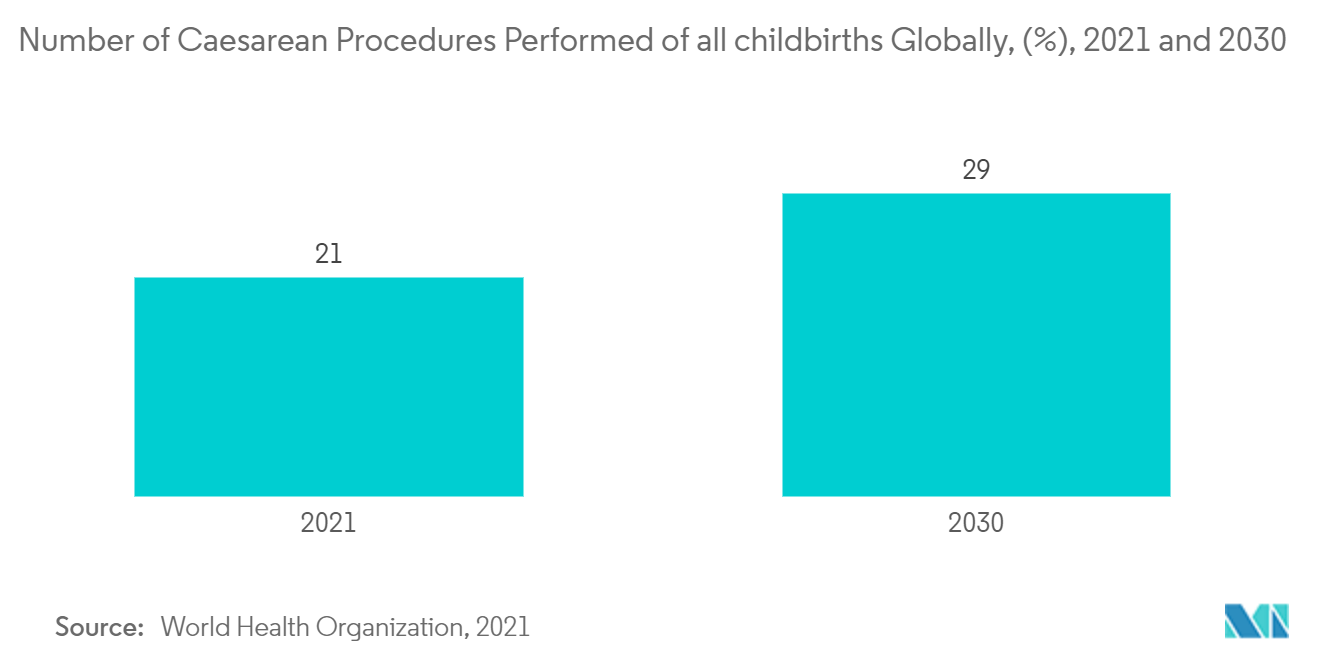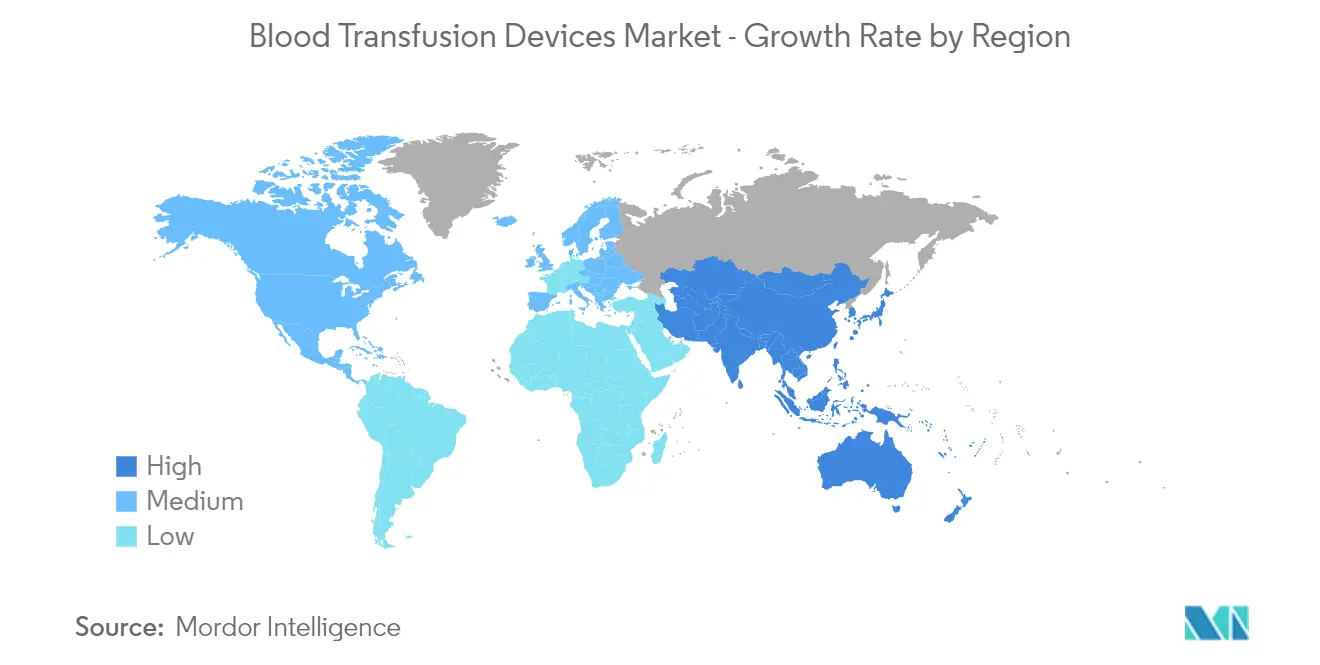Market Trends of Global Blood Transfusion Devices Industry
This section covers the major market trends shaping the Blood Transfusion Devices Market according to our research experts:
The Pathogen Reduction System is Expected to Witness a Healthy Growth Rate Over the Forecast Period
The pathogen reduction system segment of the blood transfusion market is believed to witness healthy growth over the forecast period. The demand for a pathogen reduction system is growing with the emergence of a cost-effective and innovative solution to inactivate or reduce the risk of infection. For instance, the INTERCEPT Blood System from Cerus Corporation which is effective in reducing the risk of transfusion-transmitted infections (TTI), and pathogen reduction for platelet components provides a solution to blood centers and hospital clients that ultimately benefits patients who need it most.
Blood transfusion is an almost routine medical procedure that is commonly life-saving, repleting blood losses due to surgery, injury, and chemotherapy. The rapid spread of COVID-19 has challenged healthcare systems to re-organize the management of patients in a short period. COVID-19 spreads mainly through droplets during close contact with a symptomatic patient and may be airborne during direct exposure to the virus such as through endotracheal intubation, mechanical ventilation, bronchoscopy, open suction, tracheostomy, and cardiopulmonary resuscitation.
According to a research study by Josiane Bassil et al., published in Future Sci OA Journal in September 2020, the COVID-19 pandemic has impacted medical care among these patients as blood donations were limited during the lockdown period. Mobility constraints have reduced the number of blood donations and supplies and the safety of blood transfusion was a matter of considerable concern.
Furthermore, there was a reduction in several blood transfusion procedures due to the presence of plasmatic SARS-CoV-2 RNA in 15% of symptomatic patients with COVID-19 as reported by the American Association of Blood Banks in October 2020, and the possibility of blood transmission as reported in vertical mother-to-fetus transmission in pregnant COVID-19-infected women.
According to a research study by Sudhir Rama Varma et al., published in the Journal of International Society of Preventive and Community Dentistry in November 2020, the study results found that during the COVID-19 pandemic, various technologies used to eradicate pathogens found in routine blood products, used in oral and periodontal surgical procedures. The use of pathogen reduction technology might offer a ray of light to contain the spread among dental treatment procedures.
The pathogen reduction system is used primarily for the treatment of leukostasis, caused by elevated white blood count in leukemia. It is also used in severe rheumatoid arthritis, to reduce the risk of antibody-mediated rejection of organs during, systemic lupus, Goodpasture syndrome, polymyositis or dermatomycosis, and preeclampsia and eclampsia in pregnancy. Moreover, According to new research from the World Health Organization (WHO) in June 2021, caesarean section use continues to rise globally, now accounting for more than 1 in 5 (21%) of all childbirths. This number is set to continue increasing over the coming decade, with nearly a third (29%) of all births likely to take place by caesarean section by 2030. Therefore the increasing caesarean section worldwide the growth of the segment is expected to surge over the forecast period.
The market players are offering pathogen reduction systems with different technologies. For instance, the Mirasol Pathogen Reduction Technology (PRT) system developed by Terumo's Blood and Cell Technologies Company (Terumo BCT) uses UV light and riboflavin (vitamin B2) to inactivate a broad range of pathogens, including bacteria, viruses such as HIV, parasites such as malaria, and white blood cells in blood products, reducing the risks of disease transmission and side effects from blood transfusions.
In December 2021, Health Canada approved the use of Cerus INTERCEPT pathogen inactivation technology to produce pathogen-reduced pooled platelet components at Canadian Blood Services. This approval paved the way for Canadian Blood Services to manufacture its first pathogen-inactivated blood component: pathogen-reduced platelets. Thus, owing to the above-mentioned factors it is expected to drive the segment growth over the forecast period.

North America is Expected to Hold a Significant Share in the Market Over the Forcasted Period
Some of the factors that are driving the market growth in North America region include increasing number of trauma cases and surgical procedures, technological advancements, and presence of key market players.
In May 2020, the 'The Fight Is In Us' campaign was launched, to recruit COVID-19 survivors within two months of their recovery to donate their plasma at licensed blood and plasma donor centers and also to ensure that their blood plasma contains a robust enough concentration of antibodies to have a positive effect on donating the plasma to another COVID-19 patient. The coalition was offered at more than 1,500 locations at which COVID-19 survivors can choose to donate. This campaign shows positive impact on the market growth as it has suddenly increased the number of apheresis being done at centers and hospitals by creating the awareness.
In addition, in May 2020, the Department of Defense in United States begun an effort to collect 8,000 donated units of plasma from patients who have recovered from COVID-19 to support the development of an effective treatment against the disease. This effort has given rise to the adoption of plasmapheresis devices and disposables in the United States.
According to the Terry Fox Research Institute, there is an estimated 21,700 people will be diagnosed with blood cancers in Canada in 2019. These cancers affect people of all ages, and survival rates are highly dependent on the type of blood cancer a person is diagnosed with. It is estimated that 7,500 Canadians die from blood cancers, making them the third leading cause of cancer-related death in the country.
Increasing number of surgical procedures is likely to drive the market growth. For instance, as per the 2021 updates of The Centers for Disease and Prevention (CDC) approximately 600,000 hysterectomies are performed in the United States each year. Moreover, according to the American College of Obstetricians and Gynecologists (ACOG) updates in 2020, about a third of all women will have a hysterectomy by the age of 60. These statistics also indicate the high requirement for blood transfusion devices.
In May 2021, Cerus Corporation announced its contract with Canadian Blood Services for the INTERCEPT Blood System for Platelets. The Intercept Blood System for platelets is intended for the ex vivo treatment and storage of platelet components. The system is used to inactivate a broad range of pathogens, including viruses, bacteria, and protozoan parasites, thus reducing the risk of transfusion-transmitted infections (TTI). Thus, owing to above factors it is expected to drive the market growth over the forecast period.

